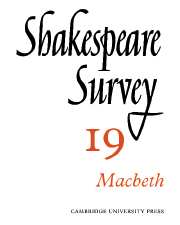Book contents
- Frontmatter
- ‘Macbeth’ in the Twentieth Century
- The Criminal as Tragic Hero: Dramatic Methods
- Antithesis in ‘Macbeth’
- Why was Duncan’s Blood Golden?
- Image and Symbol in ‘Macbeth’
- ‘Macbeth’ and The Furies
- Hell-Castle and its Door-Keeper
- ‘His Fiend-Like Queen’
- The Fiend-Like Queen: A Note on ‘Macbeth’ and Seneca’s ‘Medea
- Shakespeare at Street Level
- New Findings with Regard to the 1624 Protection List
- Shakespeare Productions in the United Kingdom: 1965
- The Royal Shakespeare Company 1965
- The Year's Contributions to Shakespearian Study: 1 Critical Studies
- 2 Shakespeare’s Life, Times and Stage
- 3 Textual Studies
- Index
- Plate Section
The Fiend-Like Queen: A Note on ‘Macbeth’ and Seneca’s ‘Medea
Published online by Cambridge University Press: 28 March 2007
- Frontmatter
- ‘Macbeth’ in the Twentieth Century
- The Criminal as Tragic Hero: Dramatic Methods
- Antithesis in ‘Macbeth’
- Why was Duncan’s Blood Golden?
- Image and Symbol in ‘Macbeth’
- ‘Macbeth’ and The Furies
- Hell-Castle and its Door-Keeper
- ‘His Fiend-Like Queen’
- The Fiend-Like Queen: A Note on ‘Macbeth’ and Seneca’s ‘Medea
- Shakespeare at Street Level
- New Findings with Regard to the 1624 Protection List
- Shakespeare Productions in the United Kingdom: 1965
- The Royal Shakespeare Company 1965
- The Year's Contributions to Shakespearian Study: 1 Critical Studies
- 2 Shakespeare’s Life, Times and Stage
- 3 Textual Studies
- Index
- Plate Section
Summary
Not everyone is, perhaps, prepared to say that ‘ Macbeth without Seneca would have been impossible’; but many would agree with Henry N. Paul when he calls Macbeth ‘the most Senecan of all of Shakespeare’s plays’. Scholars and critics have pointed out affinities with Seneca in the structural and rhetorical features of the play, as well as in those less easily definable aspects which are usually grouped together as ‘atmosphere’: the presence in action or language, or both, of night, blood and the supernatural. A number of verbal resemblances to lines in Seneca (both the original tragedies and the translations in the Tenne Tragedies) have also been pointed out, and especially Agamemnon, Hercules Furens and Hippolytus (or Phaedra) have thus been suggested as sources for Macbeth. Some critics feel that in preparation for writing Macbeth Shakespeare may have read, or re-read, at least part of Seneca’s dramatic works; and one of them thinks that, as most of the verbal echoes are from the Hippolytus and the Hercules Furens—both plays in which ‘the protagonist’s crimes are accompanied or followed by violent fear and remorse’—this indicates that Shakespeare, in turning to Seneca, paid particular attention to those plays which, compared with the others, he found ‘closer in spirit to the theme he had chosen for his next drama’. This may sound too deliberate an imitative process to those who like to think of the workings of Shakespeare’s imagination as being less conscious.
- Type
- Chapter
- Information
- Shakespeare Survey , pp. 82 - 94Publisher: Cambridge University PressPrint publication year: 1967

